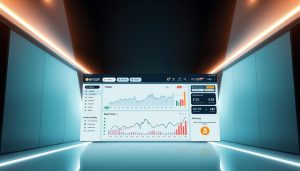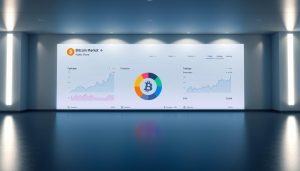Surprising fact: the network now rewards each block with 3.125 BTC plus fees, and modern rigs push past 200–300 TH/s — a scale most hobby PCs can’t match.
I started with a single rig and learned the hard way that bitcoin mining demands specialized ASICs, reliable power, and plans for heat and noise.
The practical truth: home setups often cost between $2,630 and $23,850 up front. That range covers miners like the Antminer S21 Pro (~234 TH/s) and Whatsminer M66S (~298 TH/s), plus PSUs, cooling, soundproofing, networking, and safety gear.
Profitability hinges on cheap power — under about $0.05/kWh — and pooling fees around 1–2.5%. Expect 75–90 dB noise and steady Ethernet uptime. This guide walks from unboxing to first hash, with evidence-backed numbers so you can plan realistic costs and tradeoffs.
Key Takeaways
- Modern mining centers on ASIC rigs, not general-purpose computers.
- Block reward is 3.125 BTC plus transaction fees; hardware scale matters.
- Initial setup ranges widely; expect major costs for cooling and safety.
- Electricity price and pool fees largely determine profitability.
- Prepare for significant noise and heat; robust network uptime is essential.
Mining basics for beginners: how Bitcoin mining works today
I started on a single rig and learned fast that the job is pure repetition: specialized chips try nonstop until one finds a valid SHA-256 hash.
Proof-of-Work means miners compete solve puzzles by iterating nonces inside a block header. The first valid result wins the block and earns 3.125 BTC plus transaction fees. Difficulty retargets every 2,016 blocks — about two weeks — to keep average block time near 10 minutes.
Transactions sit in a mempool until a miner picks them for inclusion. When a block is found those transactions become final on the blockchain. That finality is what secures the ledger and makes mining a payment system for new bitcoin.
ASICs from Bitmain, MicroBT, and Canaan dominate because they crush SHA-256 far cheaper per joule than a GPU or CPU. For a beginner, that means a gaming computer won’t cut it; efficiency and low electricity costs decide whether you keep profit or spend it on power.
- Quick guide: miners race, protocol adjusts difficulty, pools smooth variance.
- Reality check: rising network hash rate favors efficient, industrial setups over hobby rigs.
What equipment is needed to mine bitcoin
Every reliable rig begins with a shortlist: the miner, a stout power supply, and a safe, correct circuit. I learned this after a failed first week of unstable uptime.
Core hardware: modern asic units like the Antminer S21 Pro (~234 TH/s) or Whatsminer M66S (~298 TH/s) set the baseline for any small mining operation. Plan for a purchase range from about $2,000 to well over $10,000 depending on market supply.
Power and PSUs: most units run best on 200–250 VAC. Size your power supply at least 20% above continuous draw and keep surge protection and proper breakers in place. Stable power beats short bursts of higher hash.
Supporting gear: budget $630–$5,850 for fans, ducting, acoustic panels, Ethernet, and monitoring. Immersion or advanced soundproofing pushes that into the mid‑four to low‑five figures. Wired network gear ($50–$300) and reliable pool clients round out uptime needs.
Software and security: mining software like CGMiner/BFGMiner is free; use official firmware only. Route payouts to a non‑custodial hardware wallet, enable MFA on pool and account access, and back up recovery phrases offline.
“Stability first—fast later.”
- Choose the asic first; everything else follows.
- Respect circuits and PSUs for safety and efficiency.
- Protect payouts with a proper wallet and backups.
Power, heat, and noise: designing an efficient home mining environment
Start with the wall: electricity costs and circuit choices shape every design decision you’ll make. I learned this the hard way—cheap uptime beats occasional bursts of high hash.
Electricity planning
Target rates: profitability usually needs electricity below ~$0.05/kWh. I price power before the rig.
Most PSUs prefer 200–250 VAC. Leave amperage headroom to avoid tripped breakers at night; that kills uptime and hurts performance.
Cooling options
Airflow and ducting are low-cost wins. Basic fan cooling runs $50–$500 and drops inlet temps fast.
Immersion buys silence and stability but costs $2,000–$10,000 for a home build and needs careful upkeep.
Noise mitigation
Expect 75–90 dB from typical miners. I isolate rigs in a garage, add acoustic panels ($100–$1,000), or use an external enclosure ($500–$5,000) when family peace is at stake.
| Item | Cost range | Impact |
|---|---|---|
| Fan cooling | $50–$500 | Lower temps, low cost |
| Immersion system | $2,000–$10,000 | Quiet, best thermal control |
| Acoustic treatment | $100–$1,000 | Noise reduction |
| External enclosure | $500–$5,000 | Isolation, added safety |
Software, pools, and wallets: configuring your mining stack
Before a single hash is submitted, you must lock down firmware and pick a pool that matches your cash flow.
Safe software setup: I download CGMiner or BFGMiner only from official sites and flash firmware straight from the vendor. Antivirus often flags miner apps; create explicit AV and firewall exceptions so the miner talks to the pool without interruption.
Pool vs. solo: pools charge about 1–2.5% fees, but they smooth payouts and save stress. Solo yields huge variance unless you run industrial scale. Match payout thresholds and methods to your needs and enable failover pools for redundancy.
Wallet and payout best practices
Route rewards to a hardware wallet (Ledger, Trezor) I control. Test a small withdrawal, then move larger sums. Store recovery phrases offline on paper or steel. Never use an exchange address for cold storage.
- Keep a change-log for software tweaks and fan/power settings.
- Use wired Ethernet; it beats Wi‑Fi for steady share submission.
- Monitor pool fees and transaction fees when mempool is busy.
“Official firmware, wired network, hardware wallet—simple steps that save headaches.”
Step-by-step setup guide: from unboxing to your first hash
Start slow: verify the foundation—power and network—before the miner ever spins its fans.
I begin with the electrical checks. Confirm circuit voltage and amperage, and size the power supply for at least 20% headroom. Most modern asic units expect 200–250 VAC. Only plug in after breakers, connectors, and PSUs look correct.
Initial configuration and safe first boot
On first boot I flash or confirm the official firmware, then enter the pool URL, worker name, and payout wallet. Test a short run while I watch shares and temperatures.
Pool, tuning, and early performance work
Gently tune fan curves and power limits. I nudge settings until temperatures stay steady and the hash does not fluctuate. Add a fallback pool for redundancy so shares keep flowing if the primary hiccups.
Monitoring and maintenance
In the first 24 hours I track time‑to‑share, rejected share rate, and inlet/exhaust temperature delta. If the miner throttles, check dust, airflow, and power supply headroom before changing firmware. Log every software tweak and power adjustment.
“Small steps now save big headaches later.”
| Step | Action | Key check | Typical value |
|---|---|---|---|
| Power prep | Verify circuit and wire PSU | Voltage/amperage | 200–250 VAC; 20% PSU headroom |
| First boot | Flash/confirm firmware | Pool URL, worker, wallet | Short test run |
| Tuning | Adjust fans & power limits | Stable temps & hash | Minimal rejected shares |
| Monitoring | Set alerts and log changes | Uptime, temps, shares | Immediate notifications |
- Pro tip: set alerts for temp thresholds and hash drops so you catch problems quickly.
- Keep a simple log. Performance is easiest to fix when you know what you changed.
Costs, statistics, and a visual snapshot of your setup budget
A clear budget lets you see which purchases matter and which only add noise.
Upfront capital: count ASICs first ($2,000–$17,000), then add a PSU ($50–$300), fans or immersion cooling ($50–$10,000), soundproofing or enclosures ($100–$5,000), network gear ($50–$300), and surge/UPS ($30–$500). Totals typically fall between $2,630 and $23,850.
Recurring operation: electricity dominates monthly bills and usually decides viability. Internet runs $30–$100/month. Pool fees sit around 1–2.5% of payouts. Plan $60–$300/month for maintenance and part replacement.
| Category | Typical range | Share of capital |
|---|---|---|
| ASIC | $2,000–$17,000 | >60% |
| Cooling & noise | $50–$10,000 | 5–25% |
| PSU & safety | $80–$800 | 2–8% |
| Network & misc | $50–$400 | 1–5% |
“Electricity drives the math; model kWh at 24/7 duty and stress test against $0.05/kWh.”
- I split the budget into capital (hardware, cooling, safety) and OPEX (electricity, fees, maintenance).
- Entry builds can land near the low end; premium quiet or immersion setups push costs up fast.
- Prediction: rising difficulty or a flat BTC price moves break-even further out; efficiency gains or higher prices improve returns quickly.
Performance, profitability, and tools you can use
I track three core numbers every day: raw TH/s, J/TH, and uptime. Those three explain most of the variance I see in realized rewards over short and long time frames.
Performance means steady hash output and low power draw. A tiny drop in J/TH or a few hours offline cuts daily returns fast.
Profitability calculators let you test scenarios. Input your hash, power consumption, local kWh rate, and pool fees. They return daily and weekly estimates so you can model break-even dates.
Practical checklist
- I watch raw TH/s, efficiency (J/TH), and uptime — in that order.
- I run bearish, base, and bullish scenarios to stress-test break-even times.
- I set monitoring alerts in my software for temp spikes, rejected shares, and hash dips.
- Small, regular payouts to a hardware wallet keep on-pool balances tidy and reduce risk.
“Fees matter, but efficiency matters more — shave power consumption before chasing tiny fee savings.”
| Metric | Why it matters | Tool | Typical target |
|---|---|---|---|
| Hash (TH/s) | Drives raw rewards | Pool dashboard / miners | Match vendor spec ±5% |
| Efficiency (J/TH) | Affects electricity cost per reward | Profitability calculator | Lower is better; aim for top-tier models |
| Uptime | Directly scales earnings | Monitoring software & alerts | >99% for steady payouts |
| Break-even | Combines cost, fees, and BTC price | Scenario modeling tools — see latest market analysis | Depends on kWh and BTC path |
Evidence-backed realities, risks, and compliance in the United States
Small operators face a steady stream of challenges: rising network power, parts failing, and local regulation.
Competition and protocol trends. Industrial miners hold the efficiency edge via large power contracts and dense deployments. That push raises network difficulty and nudges home setups toward hobby economics unless you lower costs or accept slow returns.
Hardware life and environmental trade-offs
Fans, PSUs, and hashboards fail on a schedule. I plan spare units and a replacement budget because failures are part of the process.
Noise above 70 dB and steady heat matter. Environmental scrutiny focuses on energy sourcing and grid impact, so efficient hardware and off‑peak or renewable power help the case.
Legal, tax, and bookkeeping notes
Mining is broadly legal in the U.S., but states vary on zoning and energy rules. The IRS treats mined coins as income at receipt; later sales trigger capital gains based on your basis and holding period.
Records matter: keep logs of receipts, pool payouts, fees, and costs for deductions and accurate reporting.
“Rising difficulty and industrial scale force honest accounting and realistic expectations.”
- Halvings shift rewards toward transaction fees and scale.
- Plan for replacement cycles and ongoing maintenance costs.
- Use soundproofing and placement to protect relations with neighbors.
Alternatives to running rigs at home
If running noisy rigs at home feels impossible, there are paths that hand the heavy lifting off-site.
Cloud mining outsources hardware and power. It looks simple. But provider fees often stack up and scam risk is real. I check proof of hardware, clear payout history, and third‑party audits before I trust any cloud mining offer.
Hosting your ASICs keeps hardware ownership while a facility handles cooling and cheap electricity. You pay upfront and monthly hosting fees, yet gain uptime and scale. Most hosted rigs still point at a pool for steady payouts.
Full node vs. mining
Running a full node boosts sovereignty and privacy. It does not earn block rewards. For many, a node pairs well with small home experiments or as a low‑risk first step.
“Due diligence is non‑negotiable: if the cloud promise is opaque or too generous, walk away.”
- I treat cloud mining as high‑risk unless proofs check out.
- Hosting scales better for serious builders, but watch fees.
- Solo mining can be a learning exercise; for steady income, pools win.
| Option | Pros | Cons |
|---|---|---|
| Cloud mining | Low setup, no local heat | High fees, scam risk |
| Colocation / Hosting | Lower kWh, professional cooling | Upfront ASIC cost + monthly hosting |
| Full node | Sovereignty, privacy | No block rewards |
For deeper reading on solo mining choices and realistic odds, see my analysis of solo mining prospects. Add up fees, pool cuts, and likely rewards before any commitment.
Conclusion
My final take: realistic expectations, careful budgeting, and reliable uptime win more than chasing tiny tweaks. Bitcoin mining still secures the network and issues new bitcoin on a capped supply of 21 million, with current block rewards at 3.125 BTC plus fees.
If I boil it down: get efficient hardware, plan for power and airflow first, wire Ethernet, join a reliable pool, and secure payouts to a hardware wallet you control. Profitability hinges on your electricity rate, ASIC efficiency, and steady uptime; the rest tweaks the margins.
Looking ahead, halvings shift value toward transaction fees and lean operations win. In the U.S., mining remains legal with taxable mined income and capital gains on sale. Start small, document everything, and scale only after weeks of stable runs.
FAQ topics covered in this guide include earnings examples, legal questions by state, solo vs. pool vs. cloud, wallet safety, and tax treatment. Sources and evidence are woven through the article so you can plan with clear numbers and fewer surprises.
FAQ
What are the core components I must buy before starting a mining rig?
Why are ASICs dominant compared with CPUs or GPUs?
How does Proof-of-Work, block rewards, and difficulty affect returns?
What software should I install and where should I get firmware?
Pool mining versus solo mining — which suits a beginner?
How much electricity will a typical ASIC draw and how does that affect profitability?
FAQ
What are the core components I must buy before starting a mining rig?
Start with an ASIC miner such as the Antminer S21 Pro or Whatsminer M66S, a compatible power supply unit (PSU), and proper electrical circuits with adequate voltage and amperage. Add Ethernet cabling, surge protection, and a reliable router. These items form the base system for hashing and connecting to the bitcoin network.
Why are ASICs dominant compared with CPUs or GPUs?
ASICs (application-specific integrated circuits) are purpose-built for the SHA-256 hashing used by Bitcoin. They deliver far higher hash rates and much better energy efficiency (J/TH) than general-purpose CPUs or GPUs. For anyone hoping to compete today, ASICs are effectively required if you expect meaningful chances of earning block rewards or transaction fees.
How does Proof-of-Work, block rewards, and difficulty affect returns?
Miners compete to solve Proof-of-Work and propose new blocks. The current block subsidy is 3.125 BTC after recent halvings, and network difficulty auto-adjusts to total hashpower. Higher difficulty reduces the chance a single miner or small pool will find a block, so revenues vary with global hash rate, BTC price, and transaction fees.
What software should I install and where should I get firmware?
Use established mining clients like CGMiner or BFGMiner and firmware from trusted sources: the manufacturer’s site or reputable open-source projects. Keep antivirus/firewall rules tuned so mining clients can run, but avoid unknown firmware builds that can brick hardware or contain malware.
Pool mining versus solo mining — which suits a beginner?
Pools smooth payouts and lower variance. Expect pool fees in the 1–2.5% range and different payout methods (PPS, PPLNS). Solo mining can pay large rewards but is highly inconsistent unless you control very large hashpower. Most home miners join a pool for predictable income.
How much electricity will a typical ASIC draw and how does that affect profitability?
ASIC power draw varies by model; modern high-performance units often consume thousands of watts per unit. Electricity typically dominates operating costs. Targeting rates below
FAQ
What are the core components I must buy before starting a mining rig?
Start with an ASIC miner such as the Antminer S21 Pro or Whatsminer M66S, a compatible power supply unit (PSU), and proper electrical circuits with adequate voltage and amperage. Add Ethernet cabling, surge protection, and a reliable router. These items form the base system for hashing and connecting to the bitcoin network.
Why are ASICs dominant compared with CPUs or GPUs?
ASICs (application-specific integrated circuits) are purpose-built for the SHA-256 hashing used by Bitcoin. They deliver far higher hash rates and much better energy efficiency (J/TH) than general-purpose CPUs or GPUs. For anyone hoping to compete today, ASICs are effectively required if you expect meaningful chances of earning block rewards or transaction fees.
How does Proof-of-Work, block rewards, and difficulty affect returns?
Miners compete to solve Proof-of-Work and propose new blocks. The current block subsidy is 3.125 BTC after recent halvings, and network difficulty auto-adjusts to total hashpower. Higher difficulty reduces the chance a single miner or small pool will find a block, so revenues vary with global hash rate, BTC price, and transaction fees.
What software should I install and where should I get firmware?
Use established mining clients like CGMiner or BFGMiner and firmware from trusted sources: the manufacturer’s site or reputable open-source projects. Keep antivirus/firewall rules tuned so mining clients can run, but avoid unknown firmware builds that can brick hardware or contain malware.
Pool mining versus solo mining — which suits a beginner?
Pools smooth payouts and lower variance. Expect pool fees in the 1–2.5% range and different payout methods (PPS, PPLNS). Solo mining can pay large rewards but is highly inconsistent unless you control very large hashpower. Most home miners join a pool for predictable income.
How much electricity will a typical ASIC draw and how does that affect profitability?
ASIC power draw varies by model; modern high-performance units often consume thousands of watts per unit. Electricity typically dominates operating costs. Targeting rates below $0.05/kWh improves chances of profitability. Use efficiency (J/TH) and uptime to model earnings in profitability calculators.
What cooling and noise considerations should I plan for at home?
Fans produce 75–90 dB depending on the unit. Use airflow management, ducting, or acoustic treatments to reduce noise. Immersion cooling offers superior thermal control but adds complexity and cost. Proper ventilation and ambient temperature control extend hardware life.
How do I secure payouts and protect funds?
Route mining payouts to a non-custodial wallet—preferably a hardware wallet for long-term holdings. Use strong MFA for any exchange accounts, keep recovery phrases offline in secure backups, and segregate hot wallets for operational needs versus cold storage for savings.
What should I check during initial setup and first hashing?
Verify network connectivity, proper PSU wiring, and correct circuit load. Flash recommended firmware if needed, configure pool URL and worker credentials, and tune fan curves and power limits. Monitor share submission, temperatures, and uptime closely in the first 24–72 hours.
What are realistic upfront and recurring cost ranges for a home miner?
Upfront item lines vary: ASICs can range widely, plus PSUs, cooling, and networking. A conservative home setup may start in the low thousands and scale up. Recurring costs include electricity (usually the largest), pool fees, maintenance, and internet. Model these monthly to gauge cashflow.
Which metrics matter most for assessing performance?
Hash rate (TH/s), efficiency (J/TH), and uptime drive earnings. Higher sustained uptime increases share submissions and revenue. Use profitability calculators and monitoring tools to simulate scenarios across BTC price points and electricity rates.
How often do miners fail and what about replacement cycles?
ASICs can fail from heat, dust, or component wear. Fans and power supplies are common service items. Expect multi-year replacement cycles; warranty terms and availability of spare parts affect long-term costs. Regular maintenance reduces failure risk.
What legal and tax issues should U.S. miners know?
Mining is legal across the U.S., but state regulations and utility policies vary. Income from mining is taxable—miners report mined coin as income at fair market value when received, and later sales may trigger capital gains. Keep clear records of receipts, expenses, and depreciation.
Are there safer alternatives than running rigs at home?
Yes. Cloud mining and hosted ASIC services exist but require careful due diligence because of scams and opaque contracts. Hosting your ASICs in a colocation facility can reduce electricity rates and noise at home but adds hosting fees. Running a full node offers sovereignty without mining rewards.
What red flags should I watch for with cloud mining offers?
Beware of guaranteed returns, unclear fee structures, or companies with poor transparency. Legitimate providers publish hashing capacity, fees, and operational locations. Always verify reviews, contract terms, and withdrawal policies before committing funds.
How do transaction fees influence miner revenue?
Transaction fees supplement the block subsidy and can become a larger share of miner revenue over time, especially after halvings. Fee income depends on network activity and fee market dynamics—high congestion raises fees, boosting short-term miner returns.
What monitoring and management tools should I use for a small fleet?
Use pool dashboards, Prometheus/Grafana stacks, or wallet-integrated explorers to track hash rate, temperatures, share rejection rates, and payouts. Automated alerts for downtime or thermal excursions help keep uptime high and protect hardware.
.05/kWh improves chances of profitability. Use efficiency (J/TH) and uptime to model earnings in profitability calculators.
What cooling and noise considerations should I plan for at home?
Fans produce 75–90 dB depending on the unit. Use airflow management, ducting, or acoustic treatments to reduce noise. Immersion cooling offers superior thermal control but adds complexity and cost. Proper ventilation and ambient temperature control extend hardware life.
How do I secure payouts and protect funds?
Route mining payouts to a non-custodial wallet—preferably a hardware wallet for long-term holdings. Use strong MFA for any exchange accounts, keep recovery phrases offline in secure backups, and segregate hot wallets for operational needs versus cold storage for savings.
What should I check during initial setup and first hashing?
Verify network connectivity, proper PSU wiring, and correct circuit load. Flash recommended firmware if needed, configure pool URL and worker credentials, and tune fan curves and power limits. Monitor share submission, temperatures, and uptime closely in the first 24–72 hours.
What are realistic upfront and recurring cost ranges for a home miner?
Upfront item lines vary: ASICs can range widely, plus PSUs, cooling, and networking. A conservative home setup may start in the low thousands and scale up. Recurring costs include electricity (usually the largest), pool fees, maintenance, and internet. Model these monthly to gauge cashflow.
Which metrics matter most for assessing performance?
Hash rate (TH/s), efficiency (J/TH), and uptime drive earnings. Higher sustained uptime increases share submissions and revenue. Use profitability calculators and monitoring tools to simulate scenarios across BTC price points and electricity rates.
How often do miners fail and what about replacement cycles?
ASICs can fail from heat, dust, or component wear. Fans and power supplies are common service items. Expect multi-year replacement cycles; warranty terms and availability of spare parts affect long-term costs. Regular maintenance reduces failure risk.
What legal and tax issues should U.S. miners know?
Mining is legal across the U.S., but state regulations and utility policies vary. Income from mining is taxable—miners report mined coin as income at fair market value when received, and later sales may trigger capital gains. Keep clear records of receipts, expenses, and depreciation.
Are there safer alternatives than running rigs at home?
Yes. Cloud mining and hosted ASIC services exist but require careful due diligence because of scams and opaque contracts. Hosting your ASICs in a colocation facility can reduce electricity rates and noise at home but adds hosting fees. Running a full node offers sovereignty without mining rewards.
What red flags should I watch for with cloud mining offers?
Beware of guaranteed returns, unclear fee structures, or companies with poor transparency. Legitimate providers publish hashing capacity, fees, and operational locations. Always verify reviews, contract terms, and withdrawal policies before committing funds.
How do transaction fees influence miner revenue?
Transaction fees supplement the block subsidy and can become a larger share of miner revenue over time, especially after halvings. Fee income depends on network activity and fee market dynamics—high congestion raises fees, boosting short-term miner returns.
What monitoring and management tools should I use for a small fleet?
Use pool dashboards, Prometheus/Grafana stacks, or wallet-integrated explorers to track hash rate, temperatures, share rejection rates, and payouts. Automated alerts for downtime or thermal excursions help keep uptime high and protect hardware.










 Bitcoin
Bitcoin  Ethereum
Ethereum  Tether
Tether  XRP
XRP  Solana
Solana  USDC
USDC  Lido Staked Ether
Lido Staked Ether  TRON
TRON  Dogecoin
Dogecoin